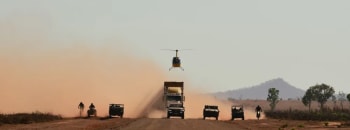DoP Mandy Walker on ‘Mulan' battle scenes, Baz Luhrmann's Elvis film
"I always begin with storytelling"
By Tiffany Pritchard 9 Mar 2021

Australian DoP Mandy Walker has shot dozens of music videos, shorts and features with the likes of Baz Luhrmann and Niki Caro’s ambitious Mulan, starring Yifei Liu in the title role.
The live-action remake captures the epic exteriors and battle sequences digitally, primarily with the large-format Arri Alexa 65 in 2.39:1, resulting in what has been lauded as Disney’s most visually rich film in years. Walker based her filming approach on the distinctive light and landscapes of China, while shooting across New Zealand with a nimble schedule of 74 days.
Both you and director Niki Caro opted to do as much as possible in camera versus in post. Which scenes show the results?
I like to do things in camera — if we are shooting with a lens flare or we want a particular look or colour or focus, we would rather do that on set because it looks more real. You can also see this with Yifei Liu’s stunts — we were able to capture her reactions in real time. Or when shooting inside the family house, we used real lanterns with LED lights to create a glow and warmth. I never want to be in a situation where I am shooting something bland and creating it in post-production.
That means a lot of camera choreography on a project like this. How did you plan the complex battle scenes, and did they involve many takes?
For the big training ground and battle scenes we went on location with the first AD — she would set up all the extras and the horses. We would go through the scenes and sequences with our lenses and plot what we were going to do. We didn’t want to waste any time. Niki hardly ever does more than five takes, mostly one or two. She believes in rehearsing with the actors so we are all locked in once we are filming.
What were your visual references for the battle sequences?
We did three scouts in China to feel the environment and to go to historical places that were relevant to the movie. I took a lot of photographs with my digital Leica and those images are a bit painterly so I said to Dan Sasaki, Panavision’s VP of optical engineering, that I want it to look like this and he worked to those specifications and created bespoke lenses. One was an 85mm Petzval photographic portrait lens based on a lens from the 1800s for when we wanted to single out [Liu] in an intimate moment. And then we had Gauss lenses and they sort of drop off at the edges where your eye is drawn to the centre.
How did that interplay with the natural light of the locations?
In China, there is a lot more atmosphere so the light is very soft. We shot predominantly in New Zealand because of the tax rebate and wonderful crews, and because we would have had to travel all over China for our locations. It’s like there’s an ozone layer hole above New Zealand and Australia — the light is very harsh. I wanted to soften it.
How were you able to maximise the impact of Yifei Liu performing her own stunts?
Niki said, “We are on a journey with this woman.” So I thought we have to find a way to connect with her even when she is in a battle with hundreds of people around her. She would pop out using the lenses created that dropped the focus of the edges, and because we put her in the centre of the frame, and often she was wearing red.
How has your background in music videos and commercials informed your approach?
I always begin with storytelling. When I first started, I thought my job was to make pretty pictures. Now one of the first things I would say to people is that storytelling is the most important thing.
What can you say about working on the untitled Elvis Presley film with Baz Luhrmann, as you did on Australia and the Chanel No5 short films?
We started filming [in Australia] last March and the film shut down for over five months [after Tom Hanks was diagnosed with Covid‑19 the same month]. Baz is a visual [filmmaker], as is his wife [costume designer and production designer Catherine Martin], and has strong ideas. It’s exciting. I mean — it’s Elvis.
Are you noticing more women who are training to become cinematographers?
I would love it if we could be just talking about talent. It will happen but we have to get over this hurdle. We have to make people aware that we are here and we are shooting great stuff. This year I have two mentees, both are women and of colour, and on the Elvis set I have two trainees, both people of colour. My [camera and lighting] crew for Elvis is also made up of 40% women. Two things I am trying to do is to train and encourage. I go to film schools and say, “Girls, you can do this.” And I’m involved with inclusion and diversity with the Academy and the ASC [American Society of Cinematographers]. It’s not just cinematographers, it’s directors, people behind the camera and those working in post-production.
This article originally appeared on sister site, ScreenDaily.
Latest news & features
Promote your services with KFTV
Choose from three profile types - Basic, Silver and Gold
Create ProfileWe offer a range of display advertising opportunities.
Learn More


